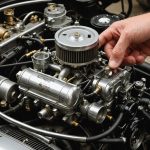Overview of Euro 7 Emissions Standards
The Euro 7 emissions standards represent a significant step forward in controlling vehicle pollutants within the European Union and other adopting regions, including the UK. Designed to further tighten restrictions beyond the existing Euro 6 standards, Euro 7 aims to address environmental impact more comprehensively by reducing emissions of nitrogen oxides (NOx), particulates, and other harmful substances.
Euro 7 emissions are set to build upon Euro 6 by implementing stricter limits across a range of pollutants. This includes introducing real-driving emissions (RDE) tests to better align laboratory results with actual on-road performance. Compared to Euro 6, which focused primarily on diesel engines, Euro 7 encompasses a broader scope, applying rigorous standards to petrol engines and, potentially, hybrid and electric vehicles as well.
Also read : Mastering the UK Diesel Car Scrappage Scheme: Your Ultimate Guide to Cashing in on Old Vehicles
In terms of UK regulations, vehicle manufacturers will face tighter scrutiny to ensure compliance, potentially influencing new car design and technology, such as advanced exhaust gas after-treatment systems. This presents both a legal obligation and an opportunity for vehicle owners. While the transition might pose a challenge, it also fosters the adoption of cleaner technologies, contributing positively to environmental impact by reducing air pollution and associated health risks.
Necessary Modifications for Compliance
To ensure vehicles meet environmental standards, specific upgrades and modifications are essential. These not only improve the vehicle’s efficiency but also reduce its environmental impact.
Topic to read : Exploring the Green Advantages of Car Clubs in Urban Areas of the UK
Upgrading Engine Components
Modernising an engine is crucial for better emissions management. Using advanced engine technologies like turbochargers and direct injection systems can significantly enhance performance while meeting compliance standards. Compliant engine upgrades might include fuel-efficient pistons and optimised valve timing. When evaluating options for engine tuning, it is important to ensure that changes align with emissions regulations and improve overall efficiency.
Enhancements to Exhaust Systems
Upgrading the exhaust system is vital for reducing harmful emissions. Mandatory catalytic converters play a crucial role in breaking down pollutants in the exhaust gases. Furthermore, incorporating particulate filters helps capture and eliminate soot particles. To maintain efficiency, regular cleaning and inspection of these components is advised.
Incorporating Advanced Fuel Technologies
Utilising low-emission fuels is beneficial in reducing environmental impacts. Biodiesel, ethanol, and hydrogen are promising alternatives that lower emissions. When considering changes to the fuel system, it’s essential to assess compatibility and potential improvements to fuel efficiency and combustion quality. These decisions can help ensure compliance with modern emission standards.
Cost and Financial Implications
Navigating the financial aspect of vehicle compliance can be daunting, but breaking down typical compliance costs is a practical start. The expenses often revolve around necessary vehicle modifications, which can include emissions control systems and software updates. These upgrades ensure adherence to environmental standards, crucial for legality and community health.
Investing in these technologies, although initially costly, can yield long-term savings. Enhanced fuel efficiency and reduced emissions often mean less expenditure on fuel and possible tax incentives. Moreover, compliant vehicles may enjoy better resale value, proving financially viable over time.
For those concerned about the upfront costs, several financing options are available. Banks and manufacturers frequently offer loans with favourable terms tailored for compliance upgrades. This consideration in financial planning helps vehicle owners manage their budgets without undue strain, spreading costs over manageable periods.
In summary, while vehicle modifications for compliance require investment, the financial advantages—such as fuel savings and increased vehicle longevity—present a compelling case. Careful financial planning and awareness of financing solutions are essential for navigating these changes effectively, ensuring both compliance and economic efficiency.
Timelines for Compliance
Understanding the compliance deadlines for Euro 7 is crucial for both vehicle manufacturers and owners. The regulatory timeline is structured to ensure a smooth transition toward reduced emissions.
Key Dates for Euro 7 Implementation
The phased implementation schedule for Euro 7 requires careful attention. Vehicle manufacturers have specific dates by which they must align their production processes with the new standards. Meanwhile, owners must ensure their vehicles meet these standards as well. Early preparation is vital; by starting compliance efforts sooner rather than later, both parties can avoid last-minute issues.
Recommended Timeframes for Modifications
Planning adequate time for vehicle preparation is essential. Recommended timeframes for modifications vary based on the type of vehicle and the upgrades required. Scheduling emissions testing well in advance of compliance deadlines is crucial. It helps ensure vehicles meet the necessary standards without penalising delays.
Potential Penalties for Non-compliance
Non-compliance with Euro 7 can lead to significant penalties. Legal fines are substantial, and there are potential risks related to vehicle insurance and registration. Penalties may increase over time, pushing the need for adhering to the regulatory timeline even further. Taking timely action mitigates these risks and secures vehicle operability within the legal framework.
Tips for Passing Emissions Tests
Preparing for emissions testing can seem daunting, but regular vehicle maintenance plays a crucial role in ensuring compliance. Start by scheduling routine checks for significant engine components like the air filter, spark plugs, and oxygen sensor. These elements directly influence your car’s emissions and overall performance.
Before your test, conduct a few pre-test checks. Ensure that your vehicle is warmed up, as a cold engine is more likely to emit a failed reading. Check for leaks in the exhaust system and confirm that the check engine light is off. A lit engine light is a common failure point during emissions testing.
Timing can significantly affect your test results. Choose a time when your car has been recently driven at highway speeds to ensure any residue buildup in the exhaust system is burned off and harmful emissions are reduced.
Remember, emission controls are designed for your vehicle’s longevity and the environment’s protection. Staying on top of maintenance and being proactive with checks not only helps in passing emissions tests but also extends your vehicle’s life and efficiency.
Importance of Compliance
Navigating the complex landscape of legal obligations is essential for maintaining public health and fulfilling environmental responsibility. Failing to meet these regulations can lead to severe consequences, including hefty fines and restrictions on operations. In some cases, non-compliance may even result in businesses being shut down.
Ensuring vehicles are compliant plays a pivotal role in reducing air pollution. By conforming to emission standards, vehicles can significantly limit the release of harmful pollutants into the atmosphere. This reduction directly contributes to lowering the overall environmental footprint and fosters a cleaner climate.
Beyond the environmental benefits, compliance enhances the community benefits. With improved air quality, there is a notable decline in health-related issues, leading to better health outcomes for residents. Communities experience fewer cases of respiratory and cardiovascular diseases, translating to fewer hospital visits and healthcare costs.
Moreover, compliance supports a fair competitive landscape where all entities adhere to the same standards. This balance ensures a level playing field, promoting innovation while safeguarding public health. Therefore, embracing compliance is not just a statutory obligation, but a step towards enhancing community well-being and safeguarding the environment for future generations.











